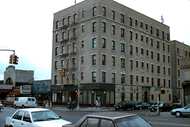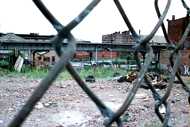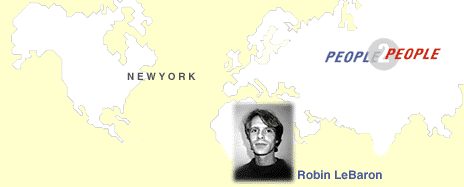| |
August 24, 1996
 My first real tour of Banana Kelly began, oddly enough, at the Hilton Hotel in midtown Manhattan. I'd been at Banana Kelly for several weeks,
My first real tour of Banana Kelly began, oddly enough, at the Hilton Hotel in midtown Manhattan. I'd been at Banana Kelly for several weeks,
 |
| Banana Kelly's offices |
but spent a lot of that time in the main office working on some miscellaneous projects. I was beginning to feel the need to get out and see more of the community.
 In mid-August, professional sociologists from across the U.S. gathered in New York for their annual conference. Amidst the presentations of papers and roundtable discussions, the conference organizers had arranged for several tours of the city, including one of Banana Kelly. It seemed like a good opportunity to learn more, so when Joe Hall, Banana Kelly's Executive Director, asked if I would go along, I went.
In mid-August, professional sociologists from across the U.S. gathered in New York for their annual conference. Amidst the presentations of papers and roundtable discussions, the conference organizers had arranged for several tours of the city, including one of Banana Kelly. It seemed like a good opportunity to learn more, so when Joe Hall, Banana Kelly's Executive Director, asked if I would go along, I went.
 Early on a cloudy Friday morning, thirty curious sociologists, Joe, and I boarded our chartered bus at the Hilton, where the conference was held. On the way up to Banana Kelly, Joe described how the South Bronx had burned down during the 1970s. Banana Kelly, he explained, was founded during those years by a group of local residents, who renovated several buildings on Kelly Street with their own labor. The group's efforts were threatened early on, when the municipal government attempted to tear their buildings down, and they secured their homes only after a standoff with city bulldozers. These buildings stood on a curving block that had been known known for decades as "the banana" - hence the unusual name. Collectors of political trivia might be interested to know that possible presidential candidate Colin Powell grew up on this banana-shaped block.
Early on a cloudy Friday morning, thirty curious sociologists, Joe, and I boarded our chartered bus at the Hilton, where the conference was held. On the way up to Banana Kelly, Joe described how the South Bronx had burned down during the 1970s. Banana Kelly, he explained, was founded during those years by a group of local residents, who renovated several buildings on Kelly Street with their own labor. The group's efforts were threatened early on, when the municipal government attempted to tear their buildings down, and they secured their homes only after a standoff with city bulldozers. These buildings stood on a curving block that had been known known for decades as "the banana" - hence the unusual name. Collectors of political trivia might be interested to know that possible presidential candidate Colin Powell grew up on this banana-shaped block.
 The bus pulled over beside Banana Kelly's main office, on the block that had struck me on my first visit as a mix of the old and the new Bronx. The surrounding area, Joe explained, lay at the juncture of several local planning districts, none of which had seen it as a high priority. As a result, it had been largely neglected for years, while other nearby neighborhoods were rebuilt, and until recently had been largely abandoned.
The bus pulled over beside Banana Kelly's main office, on the block that had struck me on my first visit as a mix of the old and the new Bronx. The surrounding area, Joe explained, lay at the juncture of several local planning districts, none of which had seen it as a high priority. As a result, it had been largely neglected for years, while other nearby neighborhoods were rebuilt, and until recently had been largely abandoned.
 Banana Kelly intervened abour four years ago. One of its first actions was to renovate a large brick building, which had been a center for drug dealing. As a symbol of its commitment to the area, it moved its main office to the building, while renovating several others. South Bronx Churches, another local community development organization, complemented these efforts by building the cluster of suburban-style Tudor houses.
Banana Kelly intervened abour four years ago. One of its first actions was to renovate a large brick building, which had been a center for drug dealing. As a symbol of its commitment to the area, it moved its main office to the building, while renovating several others. South Bronx Churches, another local community development organization, complemented these efforts by building the cluster of suburban-style Tudor houses.
 Although this development is already visually impressive, Joe outlined even more ambitious plans for the rest of the block. The empty warehouse
Although this development is already visually impressive, Joe outlined even more ambitious plans for the rest of the block. The empty warehouse
 |
| A Vacant lot. |
beside the office is slated to become an outpatient center linked to a large Bronx hospital. Rite-Aid has committed to building on the vacant lot across from the office, and Banana Kelly is currently negotiating with other retail organizations to occupy the rest of the space. It is also hoping to convince a bank to set up an office on the site. And plans spearheaded by Banana Kelly to redevelop the run-down commercial strip along the elevated subway lines are well underway.
 This was the first time I had heard most of this, and I looked at the block with new eyes. I imagined it four years ago, looking like the empty lot nearby ‹ stony, sparsely covered by ragged weeds, and littered with broken glass, tires, and an old mattress. By contrast, its current state was impressive. Then I thought about the vision Joe had sketched for the future - a renovated commerical strip, a sorely needed bank, new medical facilities. Bringing this about will require immense effort. But as we soon saw, Banana Kelly is entirely capable of working miracles.
This was the first time I had heard most of this, and I looked at the block with new eyes. I imagined it four years ago, looking like the empty lot nearby ‹ stony, sparsely covered by ragged weeds, and littered with broken glass, tires, and an old mattress. By contrast, its current state was impressive. Then I thought about the vision Joe had sketched for the future - a renovated commerical strip, a sorely needed bank, new medical facilities. Bringing this about will require immense effort. But as we soon saw, Banana Kelly is entirely capable of working miracles.
- to be continued next week
| |




